Asian Financial Crisis Lessons, Can Malaysia’s Capital Controls be Copied?
Stock-Markets / Credit Crisis 2012 Sep 24, 2012 - 12:49 PM GMTBy: Sam_Chee_Kong
 The Asian Financial Crisis in 1997 came as a surprise and caught most people by surprise not only by the speed but also the severity of the crisis. At that time the Asian Economic Miracle was the buzzword then and the Asian Tiger economies are at their peak not only in the performance of their export oriented economies but also the stocks and properties market. To accommodate the shortage of funds needed to boost their economies, their governments embark on a ‘loose money’ monetary policies regime.
The Asian Financial Crisis in 1997 came as a surprise and caught most people by surprise not only by the speed but also the severity of the crisis. At that time the Asian Economic Miracle was the buzzword then and the Asian Tiger economies are at their peak not only in the performance of their export oriented economies but also the stocks and properties market. To accommodate the shortage of funds needed to boost their economies, their governments embark on a ‘loose money’ monetary policies regime.
Loose Money Policy
Rules governing the inflow and outflow of foreign funds are relaxed and so does the terms of borrowing by banks and corporations. Instead of the traditional ‘borrow long lend short’, banks then did the opposite and they ‘borrow short lend long’. Such practice will put bank in a precarious position because if they borrow short say 3 years and lend long for 10 years then there will exist a ‘window of interest rate risk of 7 years’ , from fourth year to the 10th year. It will put the banks in a extremely risky position. This because during a financial crisis, a country’s currency will most likely be victim to currency speculators when they start attacking their currency .
Currency depreciation
Normally there are two monetary tools available to the authorities to fend off the currency speculators. One is to raise the domestic interest rates and the other is to defend its exchange rate by using its reserves to artificially prop up its currencies. As usual once the reserves dries up then the currency will continue to fall.
While defending their currencies, the authorities will raise their interest rates which resulted in the increased in the ‘cost of funds’ for the banks and corporations. As a result, it will be very prohibitive for them to service their debts. If left unchecked, it will send many of them into bankruptcies.
I still recalled during the height of the Financial Crisis in 1998, the interest rate in Malaysia went up to as high as 18%. Coupled with the currency devaluation it provided a double whammy to many of the businesses in Malaysia. To do business in Malaysia then was very difficult due to the wide trading band between the Ringgit and US$. Many businesses found that whatever they have quoted their customers a week ago resulted in a loss due to the depreciation of the Ringgit. In other words the business activity came to a halt. The Malaysian Government needs to do something to stem any further devaluation of the Ringgit. In the next few sections we will delve into this topic.
Due to the length and depth of this article, I will separate it into the following parts.
- Pre Crisis – How it started
- During the Crisis - How the Malaysian Government responded
- The aftermath - How did Malaysia’s economy performed as compared to those that embraced the IMF assistance during the Crisis. Is our solution to the crisis a desperate move for crony bailout or an economic crisis stabilization program? Instead of weeding out the deadwoods did the authorities use this opportunity to reinforce the ‘Bumiputra’ grip on the economy at the expense of other races.
Part One – Initiation of the Crisis.
Before we delve into the possible reasons for the Crisis , I think it is best to take a look at the chronicle of events leading up to the crisis. The following is the table describing the various events.
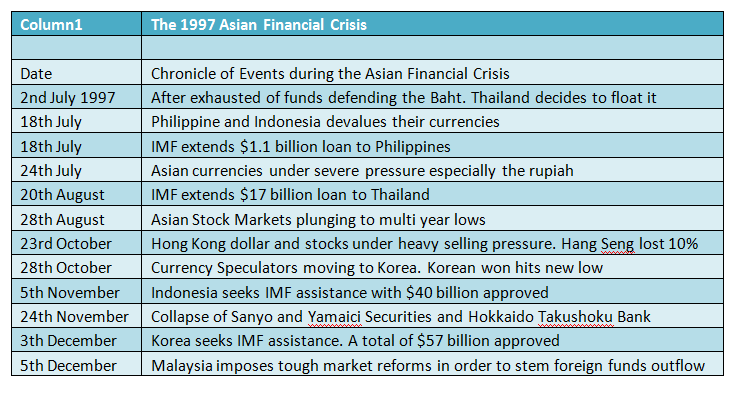
As with all Financial Crisis, there are caused by multiple factors. The Asian Financial Crisis of 1997-98 is no exception. Listed below are some of the most debated reasons for the onset of the Asian Financial Crisis.
- Deteriorating economic conditions
- Moral Hazards by banks and corporations
- Too much inflow of foreign funds
- Stock market and Real Estate Bubble
- Lack of regulatory control on funds
- Massive disinvestment by the Japanese during the early 1990s due to their misadventure in the U.S coupled with their stock market crash. This resulted in the recalling of funds in the region by Japanese banks.
In the following, we shall provide an account on the few most possible factors for the initiation of the crisis.
- Liberalization of the Financial Sector
As from our discussion above due to the credit boom in the international front and the relaxation on foreign capital inflows by the authorities, it led to an increase in the foreign capital inflow. Normally the funds will find its way into either the real economy in terms of loans to businesses or the unproductive stock and property market. Unfortunately during that time the capital inflow are directed towards the stock and property market. The following table shows the percentages of the loans given to the property sector and also the NPL during 1997.

Source : Bank of International Settlement
As can be seen from the above the four countries that are most affected by the crisis also coincide with having the highest NPLs in their respected banking industry.
The following chart is the effect of the Financial Crisis on the respective GDP growth of those countries.
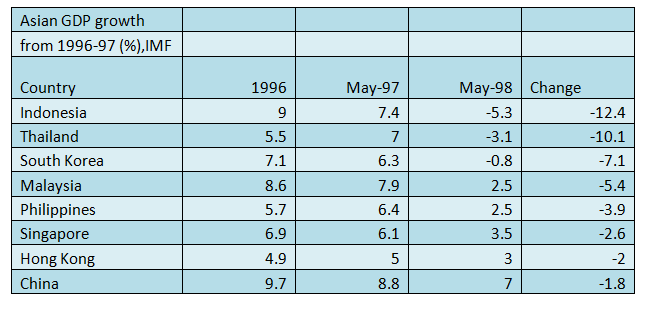
Source : International Monetary Fund (IMF)
- Fiscal Imbalances
Fiscal imbalances refers to the difference between the negative balance of payment and the ability of a country to pay its debts.
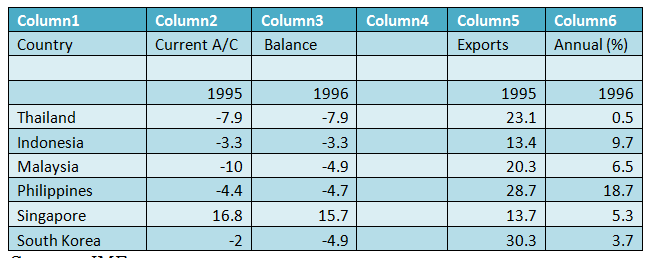
Source : IMF
The above table shows the deterioration of the Exports and Current accounts. The table shows that while the current accounts deficits remains high, the exporting countries at the same time are experiencing a downturn in its export receipts. In South Korea and Thailand, their exports grew the least with only 3.7 and 0.5% respectively. This compared to 30.3 and 23.1% respectively a year earlier. Hence this represents a fiscal imbalance of reducing exports with persistently high current account deficits. In other words eventually export receipts will not be enough to pay for its current account deficits.
Due to the boom in the exports, there is a need of funds to finance its exports industry and other increase economic activity. At the time the liberalization of the Global Financial market provided a perfect avenue to source for external funds. However, eventually such borrowing will widen the current account deficits.
When a country’s current account deficits widened coupled with the drop in exports and an overvaluation of the currency due to the inflow of foreign funds, it will attract the attention of currency speculators. Currency speculators will eventually attack the domestic currency and the end result will be currency depreciation.
The governments of the affected economies will try to defend its currency either by increasing the interest rates or using its foreign exchange reserves to prop up the currency. When they increase the interest rates it will eventually bring down the banking sector due to the increase cost of borrowing abroad. Eventually there will be a ‘reverse flow of funds’ from an inflow to outflow of foreign funds. With such outflow of funds it will result in a credit crunch and coupled with the high interest rate it will eventually bring down the real estate and banking sector.
The relationship between the balance of payment crisis and the banking crisis is much more evident nowadays due to the globalization of the financial industry. The following table shows the frequency of the crisis between banking and balance of payments.
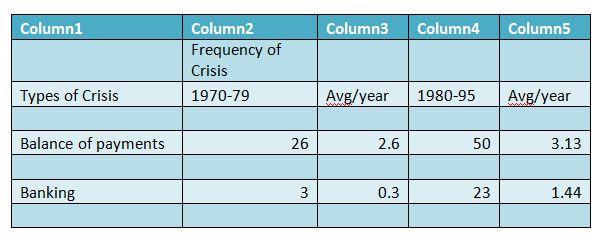
As can be seen from the above table, before 1980 the occurrence of crisis is more biased towards the Balance of Payments. Out of the total of 29 Crisis only 3 are banking crisis. However since the 1980s the total banking crisis rose to 23 out of 73. So we can deduce that somehow the modern day financial crisis may be caused by the relationship of both balance of payments and banking.
In other words a Banking crisis may predate a Balance of payment crisis and vice versa.
- Deterioration of Bank Balance Sheets
Since the factors affecting the Crisis are inter-related and when currency speculators sense there is a weak link between the various component of the economy like an over-valued currency, persistent high negative balance of payments and falling exports then there will be an opportunity to make big money by betting on a depreciation of the currency.
During the 1990s era most of the Central Banks in Asean pegged their currencies against the dollar. The short term benefits of such a move are creating a stable environment for the inflow of foreign investments and also no headaches on daily fluctuation of exchange rates. The disadvantage is that Central Banks will have to maintain the peg even at the expense of over-valuing their currencies.
Again when currency speculators found out that the central banks are maintaining an over-valued currency then they will be subjected to a speculative attack. Soon they will flood the market with massive sales of the currency and this will create a condition where supply outstrips demand and eventually the collapse of the currency. The central bank will first try to counter the move by selling the dollar and buying up the local currency. However with such massive sales of the local currencies by the speculators, central banks will soon used up their holdings of their foreign reserves. Once their foreign reserve is exhausted then currency devaluation will continue. Such a move will always fail because the foreign exchange market is not only unregulated but also it trades about $4 trillion a day. No central banks succeed in defending their currency this way.
Another avenue is to raise the domestic interest rates. By increasing the interest rates it not only helped to prevent further capital outflow but also encourage capital inflow. However such a move will have an effect on the bank’s balance sheet because of the higher cost of funds to obtain funds. If left unchecked it will eventually lead to the collapse of the weakened banking sector. If they don’t increase the interest rates then they will not be able to maintain the currency peg which will eventually collapse. In other words the Government and Central Banks are in between a rock and a hard place.
So how do Central Banks counter such a situation? In our next article we will explore how the Malaysian Government used its monetary policy tools to help it stem the onslaught.
Before we proceed further, we present below a flowchart that will illustrate the dynamics of the Asian Financial Crisis.
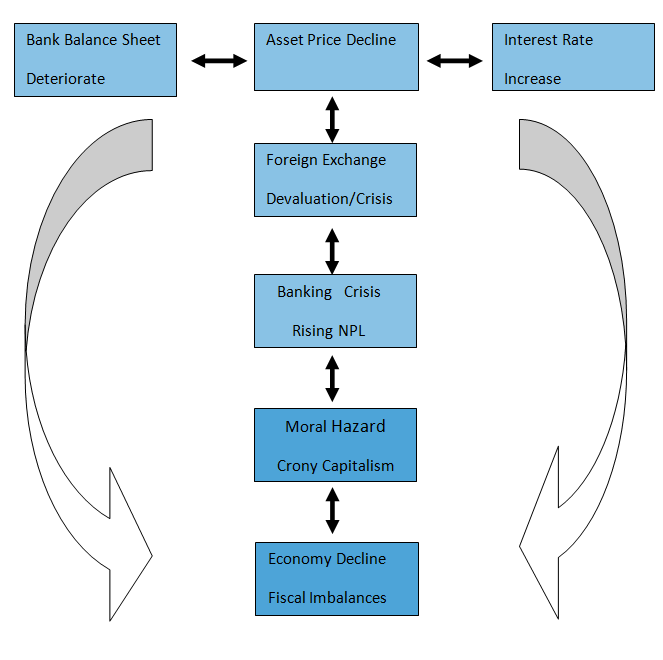
Vicious Cycle of Financial Crisis
Why no alarm Bells before the crisis?
What surprises everybody is that there are no signs on the impending crisis because the economic indicators show no signs of rapid deterioration. The only signs are the falling stocks and property prices. In January 1996, Thailand’s stock market felled 40% as with Korea’s bourse which also felled sharply at the end of 1996. Malaysia’s stock market also dived during the early 1997. The following is the timeline of events occur in Malaysia’s during the 1997 Financial Crisis.
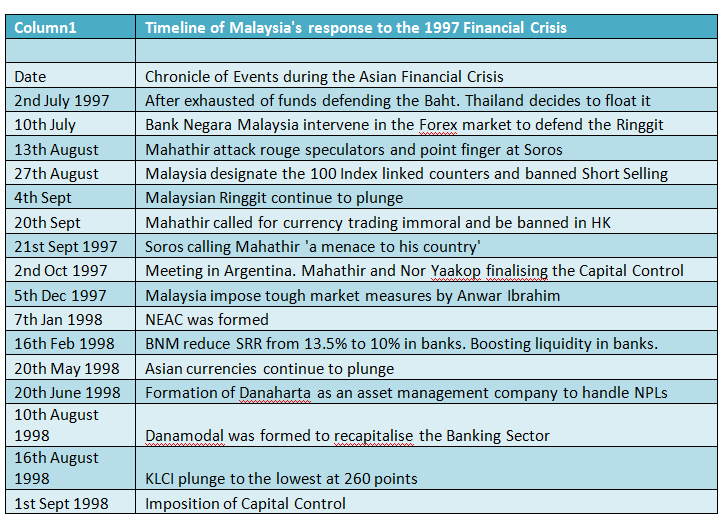
In view of the deterioration of Malaysia’s internal and external sectors, time is of essence. To tackle the problem Malaysia established the NEAC (National Economic Action Council) in 7th January 1998, which was based on ideas and policies of NOC (national Operation Council). NOC was formed as a result of the 1969 racial riots. The NOC was given executive power so it can override all the red tapes and jurisdiction of different ministries to ensure the smooth implementation of policies.
The main objective of the NEAC are as follows :
- Restoring both public and investor confidence.
- Make sure it will be a soft landing for the economy.
- Reposition and revive the economy to enhance competitiveness and also its attractiveness to foreign investors again.
- Strengthen the economic fundamentals to ensure vision 2020 will be achieved.
The following is the flowchart of the NEAC structure
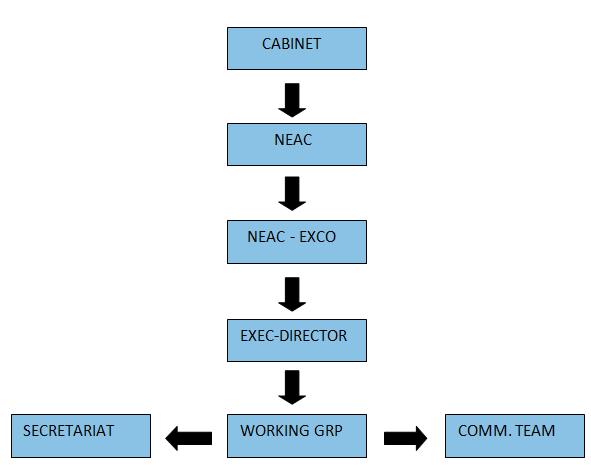
The NEAC consist of 26 members with the Prime Minister (Dr Mahathir) and Deputy Prime Minister (Anwar Ibrahim) as the Chairman and Deputy Chairman respectively. While the remaining consists of representatives from various Ministries , Governor of Bank Negara Malaysia, EPU, NEAC EXCO, Executive Director, Secretariat, Working Group and the NEAC Communications Team. The NEAC EXCO was chaired by the Prime Minister while the Executive Director was chaired by ex-Finance Minister Tun Daim Zainuddin. The Secretariat was staff by EPU officials and the Working Group members consist of Tan Sri Wan Azmi (Land and General), Datuk Dr Zainal Aznam Yusof (ISIS), Tan Sri Thong Yaw Hong (Public Bank Chairman) and Professor Mahani Zainal. From the above timeline it is clear that even after a series of measures adopted, the Ringgit and stock market is still plunging. Hence as a result, desperate situations needed desperate measures and capital control follows next.
The idea of capital control was originated during Mahathir’s trip to Argentina. The Chief architect of Malaysia’s capital control is Nor Yakcop. Formerly he was running the foreign exchange trading desk in Bank Negara and the very same man that caused Bank Negara Malaysia to lose about RM 30 billion 20 years ago and now the Finance Minister of Malaysia. Other members of the group that caused the forex scandal includes ex-Prime Minister Dr Mahathir, ex-Finance Minister Daim Zainuddin and ex-Bank Negara Governer Datuk Jaffar Hussein. According to ex-Bank Negara Deputy Manager, Dr Rosli Yaakop the main culprits are Nor Yakcop and Datuk Jaffar in speculating and gambling away Bank Negara funds. To create an impression that Bank Negara had ‘a team of forex traders’ Nor Yackop used his and the staff’s computer to do the buying and selling.
The real reason for the loss of RM30 billion in the foreign exchange misadventure is due to Nor Mohamed Yackop’s bet that the Bank of England would float the Sterling during the 1992 European Financial Crisis. Mahathir ordered Bank Negara to purchase large amount of the Sterling in the hope that it will appreciate once it is floated. Meanwhile his rival on the other end of the bet is George Soros who through his Quantum Fund established short position using currency forward contracts and options to the tune of US10 billion. Other currency speculators sensed the kill soon join in the fray and they together drove the pound down. Soros walked away with US1 billion for a day’s work while leaving Mahathir with more than RM30 billion loss. Later Soros is known as ‘the man who broke The Bank of England’. This is the main reason why Soros was so unpopular with the Malaysian media. He and Mahathir have gone into many heated arguments and name calling later on during the Asian Financial Crisis.
While in Argentina Mahathir called upon Nor Mohamed Yackop (since he was the only dude that had the most experience with foreign exchange) to enlighten him on the inner workings of the foreign exchange market.
At the same time Mahathir asked Nor Mohamed to design the country’s capital control policy. Practically what he (Nor Mohamed) done was he went through the Country’s Balance of Payments report line by line looking for any leakages to prevent any capital outflow from the country.
Needless to say this strategy proved to be too complicated to comprehend and also caused a lot of confusion later on. The border control forms and other forms that designed to track the movement of the ringgit proved to be very confusing. Due to the lack of time and to fast track the process these forms are copied from other countries, presumably from Argentina and other Latin American countries since they are the experts in capital control. For example one of the conditions for funds raised from the sale of equities and other investments had to be remained in the country for a minimum of 12 months. It is not specified whether the residents and the locals are required to do so and consequently it created a lot of confusion. As a result the NEAC Communications Team was formed to deal with the problem and also in educating the people.
Capital Control implementation
The NEAC had been toying with the idea of Capital control many times in the past. Bank Negara Malaysia had been the most ardent opposition to the use of capital control knowing its repercussions or after effects. From empirical analysis of other countries that have adopted capital control, any future capital raising in the international markets will be shunned by investors and hence the costs of funds.
Before we go further into Malaysia’s foray into implementing its capital control, I think its best for us to understand Capital control. When a country runs out of Monetary tools to stabilize its economy and confidence during a financial crisis, the last resort or attempt will be to implement capital control. It will only be implemented when funds are leaving the country in a big way.
Capital control is an attempt by any Government to introduce policies to control the free flow of funds in and out of the country and also within its borders. Below are some of the more common types of capital control.
- Controlling the foreign exchange transactions.
- Controlling the international bank transfers
- Confiscation of Precious metals like gold and silver
- Fixing the Exchange rate
- Controlling the amount for bank withdrawals
On the 1st day of September 1998, Prime Minister Dr Mahathir Mohammad announced the capital control. Malaysia's capital control is a mix of the above measures (Rojak in Malaysian) and nothing new at all despite what the press claimed it was unique or the one and only in the world because Malaysia did not embrace the IMF. The following measures are taken to ensure that the objectives of stabilizing the Ringgit and control the capital flows are accomplish.
- Overseas bound Local travelers are only allowed to take up to RM1,000.
- Remittance of funds by residents to overseas are capped at RM10,000.
- Ringgit is pegged to the dollar at the rate of RM3.80 to US1 to facilitate trade in the domestic sector.
- Any ringgit remains outside of Malaysia considered not legal tender. This is to prevent speculators from borrowing the ringgit offshore to sell it in the domestic market for dollars. In other words to perform short selling on the ringgit and when the ringgit depreciates they will buy it back to repay their offshore ringgit loan.
- Any credit facilities obtained overseas need to seek approval first and only companies that earn foreign exchange are allowed to obtain offshore credit.
- Funds raised from the sale of equities or other forms of investments need to be remain in the country for 12 months. This is to prevent short-term capital flight.
- Clearing of Stocks listed on the KLSE can only be done on the KLSE or its approved exchanges.
- RM500 and RM1000 currency notes are made non legal tender to prevent smuggling of Ringgit to neighboring countries.
- Dealing of shares in CLOB was made illegal to prevent the flow of funds to Singapore and also discourage the arbitraging of shares between the two exchanges.
Reasons for Malaysia’s success
The end result of the capital control is it does bring some stability to the economy because the exchange rate had been stabilize and also there is did not exist a black market for the Ringgit. There are many different views on Malaysia’s success in implementing capital control without many ill effects in the short run. The following may offer the best explanations for Malaysia’s success.
- Its Authoritarian Government.
Asian values such as maintaining good relationships, respect the elders, upholding harmony and family closeness are some of the reasons that enabled the existence of an Authoritarian Government. Authoritarian Government is one of the main element for the rapid economic growth in Asean. Singapore’s government under Lee Kuan Yew is often criticized for being too authoritarian and so does Dr Mahathir Mohammad and Indonesia’s Suharto.
Being an authoritarian government it enabled Mahathir to push both state-led and private corporations into cohesion so as to achieve its objective. The pursuit of autonomy on its economy started since the May 13th 1969 racial riots. It was agreed that the main reason for the racial riots is due to the inequality of income distribution between and Chinese and the Malays. The Chinese seems to be predominantly controlling most businesses and hence at the expense of the Malays. In order to ensure more equitable distribution of income The New Economic Policy was born in 1971. To close the gap between the Malays and the Chinese business licenses, monetary assistance, employment in public enterprises, property purchase discount (10%), ownership quota (minimum 30%), universities intake (more than 90%) and a myriad of other discriminatory policies are enacted.
It would be a dream for Western politicians to exert such autonomy on their economy and its people. So the 1997-1998 crisis provided another platform for Mahathir to seek autonomy and this time from the international investors. At that time (end of June 1998), the Ringgit was plunging towards the RM4.80 mark, capital flight is increasing and interest rate is sky rocketing.
- The Crisis is Urban confined
Due to the structural transformation of the Malaysian economy since the 1980s after the Crash of the tin price which was brought about by Mahathir’s effort to corner the tin market in 1980. His effort had caused Malaysian taxpayers more than RM 1.6 billion. In December 1980, Malaysian Mining Corporation through its subsidiary Maminco (short form for Malaysian Mining Corp) secretly made larger purchases of tin futures in the LME to the tune of 50,000 tones. As expected the tin price went up furiously and it not only attracted the attention of other tin producers from Brazil and Indonesia to increase their capacity by 69% but also the US to release its strategic stockpile.
Needless to say eventually the tin price crashed. The crash not only left Malaysia with more than RM 1 billion in losses but also devastated many mining towns in Malaysia. Another thing is that it not only cost Malaysia another source of income from tin mining but also its reputation as ‘The largest tin producer in the world’. I was from Ipoh and during the 1970s it was the most prosperous town in Malaysia and it is also known as the ‘Tin City’. Eventually most tine miners closed shop and went into other business and Ipoh had now been transformed into ‘Eat City’ with specialty such as bean sprouts chicken, salted steam chicken, fried rice noodles, white coffee, beef noodles, fish ball noodles and many more. Heck! if any of you folks want to savor any of these specialty please give me a call, I am more than willing be a tour-guide.
Anyway back to business, Malaysia has since been more diversified by transforming from an agrarian economy to a manufacturing economy. Import substitution and export-led industries such as electronics are the main activities and contributed much as the engine of growth.
At the same time the high price of agricultural commodities such as palm oil and rubber also helped cushion the impact of the crisis in the rural areas. This is because the rural economy depended much on rubber and palm oil plantations and it not only insulated it from the onslaught of the crisis but also contributed to the vibrancy of the rural economy. Hence , Malaysia had one less problem to tackle and it can now concentrate its fight on the urban economy.
- Malaysia’s Debt/GDP was smaller
Due to Bank Negara Malaysia’s stringent control on offshore borrowing by local corporations, Malaysia’s external debt did not pose any danger to its Debt/GDP ratio. This in response to its earlier experience during the 1987-1988 crisis. Only Malaysian companies that are earning foreign receipts are only allowed to raise capital overseas. Hence this helped it to control its external debts especially the short-term ones. The following table shows the Debt/GDP of the most affected countries during the crisis.
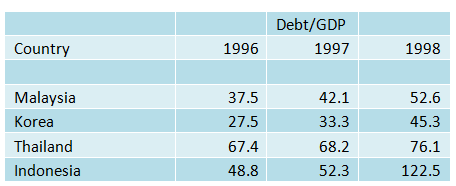
Hence with a relatively lower than its neighbor Debt/GDP it helped Malaysia to escape much of the brunt of the crisis.
- Delayed response to the crisis.
There has been much argument that Malaysia’s delayed response to the crisis is akin to the steps taken to ‘kick the can down the road’ by Western countries to address their current financial crisis. Western countries are using all types of measures such as QE, LTROs, TARP, Target2 and etc to inject funds into their economies in an attempt to reflate their economies.
By the time Malaysia imposed the capital control (1st September 1998), the crisis had already devastated other countries by more than a year. Much of the foreign capital that had already left are coming back to ‘bottom fish’ so as to say, since much of the equities and asset prices are offering at rock bottom prices. Further to that those IMF-3 economies that embrace IMF aid are on their way to recovery. Hence, this provided a less risky approach to implement capital control then and spared Malaysia’s on much of the catastrophic effects of capital control such as currency black market.
Another main reason for the delayed response is the internal bickering between Mahathir and his deputy (Anwar Ibrahim – Finance Minister then). The imposition of the capital control is ‘purposely timed on 1st September 1998’ because they know that Anwar is going to be sacked the next day. If capital control is imposed after Anwar is sacked, then heck there will be another round of capital flight not only from Malaysia but also from the IMF-3. The situation will turned worse and might undermine the recovery efforts of their economies.
- Absence of black market currencies
One of the associated side effects of capital control is the creation of a black market for currencies. Due to the increased demand for US$ more people will be willing to pay more Ringgit for the dollar. Hence in the black market instead of the stipulated US$1 to RM 3.80 people are willing to pay more say RM 4.00.
This does not happen in Malaysia because due to the authoritarian nature of the government, Bank Negara Malaysia can exert full control on the commercial bank operations. Commercial banks then are warned not to mess around with the black market and also the government through the NEAC liaise the Bank Negara with the Customs Department in order to control the smuggling of the Ringgit and dollars between its border with Singapore and Thailand.
Since capital control means that the dollar’s movement in and out of Malaysia will be curtailed and this will create an impression that the supply is limited. Hence this will lead people to hoard the currency. Added to this people are afraid when the Ringgit devalues again so they are willing to pay more for the dollar to stash it in their vaults or under the pillow. Such a move will also means that the value of the Ringgit has gone down and hence if not curbed will lead to inflation. Another effect will be the loss of confidence on the Ringgit and traders will refuse to accept Ringgit being afraid that it will lose it value soon. During the crisis I still remember there is a ‘capital flight to safety’ of deposits from local banks to foreign banks. People are withdrawing their savings enmasse from local banks because they are afraid that the banks will collapse.
Why took so long?
However there have a lot of skeptics from many quarters as to why it took so long for the capital control to be implemented? It took more than one year since the crisis started on 2nd July in Thailand. The following may be the reasons for the delay.
- Running out of options. The authorities have tried many selective capital controls and unorthodox economic approach to stabilize the Ringgit. This also served as a stop gap measure for it to buy more time so that when other countries start recovering Malaysia will then participate in the recovery which will help to turn around their economy.
One of moves involves the selling of dollars by Malaysian exporters with large dollar receipts. The idea is to use the Malaysian companies to sell their dollars for Ringgit which in turn will push up the value of the Ringgit. This will provide more pressure for the currency speculators to cover their shorts and at the same time make it more expensive. However due to the overwhelm sales of the Ringgit by the speculators the local companies are unable to cope and finally gave up their attempt. Unfortunately this scenario did not play out. Since time is of essence and if capital control is not implemented then Malaysia will surely be sent to the Cleaners (bankruptcy) or the IMF.
- Timing of the execution. A different approach between Dr Mahathir and his Deputy Anwar Ibrahim who is also the Finance Minister then. Anwar was the blue eye boy of Washington and even the Wall Street Journal called him the ‘calm voice of economic reason’ during the crisis. Anwar prefers the orthodox approach of free market enterprise policies like increasing the interest rate to protect the ringgit and also the contractionary fiscal policies to balance the budget following the lines of the IMF austerity program. Their difference led to the sacking of Anwar on 2nd September, a day after the imposition of the Capital control.
The actual reason as we have already discussed above, for the imposition of the capital control a day earlier was to prevent a ‘second round of capital flight’ from Malaysia. If capital control is not implemented by then, there will surely be another round of massive capital flight and this time Malaysia will not be able to survive the crisis. Hence the IMF will be the next option.
Mahathir know that if the IMF were to allowed to come in then his legacy as well as the NEP’s (New Economic Policy) unfair policies that had been implemented for the past 20 over years will be dismantled. Not only that public enterprises and private corporations that are not competitive will either be sold or merged.
Malaysia’s bloated civil service will also needed to be trimmed. Loss making banks and other financial institutions will be either closed down or sold to foreign banks. Foreign banks are allowed to own up to 100% equity in local banks like those in Indonesia. Malaysia’s national car project PROTON, Perwaja Steel, all the IPPs (Independent Power Producers), Light Rail Transport, PLUS, Indah Water, AMMB, RHB, Bank Bumiputra, Renong Group and other remnants of crony capitalism will have to go. There will be no more ‘Bumiputra status’ because IMF believes in equal opportunity policies. In other words, Joseph Schumpeter’s creative destruction where survival of the fittest will prevailed.
Long term Negative effects
In the short term there are not many negative effects on its economy but it was felt in the long run. Malaysia’s image had been tarnished and damage had been done. This is because in the world of international finance there are not many major players and especially in the investment banking and hedge funds it is a tightly knit community. This is one of the reasons why Malaysia is off the radar screen when it comes to Foreign Direct investment. The capital inflows seem to be going to either Thailand, Indonesia or the Philippines and this may may help explain Malaysia’s dwindling FDIs.
Indonesia seems to be doing everything right in the past such as liberalizing its financial sector and also encouraging market reforms under President Susilo Bambang Yudhoyono. This year alone it managed to attract two mega FDIs to the tune of US$10 billion a piece. Malaysia’s Robert Kwok who had been forced to relinquished his sugar monopoly business in Malaysia is investing US10 billion into the palm oil plantation while Taiwan’s Foxconn is said to be pledging US10 billion to open a plant in South Jakarta next year to assemble Apple products such as iPods and PC. Another notable investment is Singapore’s DBS multi billion dollars acquisition of Bank Danamon this year.
The upgrading of Indonesia’s Sovereign rating to ‘investment grade’ by Moody’s and Fitch does help in attracting further FDIs. Companies that are previously unable to invest in Indonesia due to the ratings constraint can now have the opportunity. In the first half of this year total FDI increased 28.1% year-on-year to Rp 107.6 trillion. According to its investment chief M. Chatib Basri ‘Indonesia can achieve a target of 206.8 trillion Rupiah in FDI this year which would easily topped 2011’s record of 175.3 trillion rupiah and Indonesia potential still can rise’. Another thing is that the total FDIs in Indonesia is actually bigger than reported because investments in the oil and gas and the banking sector is not included such as the DBS deal.
Why Malaysia lagged?
- Crony Capitalism still persists until today. Should Malaysia have taken the IMF path and with its austerity measures, crony capitalism in Malaysia would have come to an end. With IMF’s austerity measures weak companies are forced to close down or be sold to foreign companies. There will be no more monopolies or duopolies in our economy. Bailouts will be out of the question and ‘creative destruction’ will work its way through the economy.
After more than 14 years since the Asian Financial Crisis, Malaysia still goes back to its old practice. Political cronies are controlling too much of the country’s wealth. The last time was Halim Saad’s Renong Group which had a market capitalization of RM 20 billion which collapse during the last crisis. Now it is Syed Mokhtar’s Group of companies which have its hands on most major business from car manufacturing to hotels in the country. The market capitalization of his group of companies is worth about RM 34 billion. This is why there we have so many scandals in our country, we have cow-gate, prawn-gate, Water-gate, submarine-gate and the lists can go on and on. The number of scandals in this country will make Western countries scandals like Iran-gate, Libor-gate, subprime-gate and what have they seems like ‘a walk in the park’ because anything below RM1 billion seems like a considered small change.
- Continued outflow of professionals to other foreign countries. This phenomenal is also known as ‘Brain Drain’ and the main cause is due to unequal opportunities. In Malaysia, to climb up the corporate ladder it is not what you know but who you know that is more important. In education more than 90% of the places in the tertiary education are allocated to the ‘Bumiputra’ and hence the chances for other minorities to enter universities are very slim even they have good grades. It must be noted that future economic growth depends on today’s investment in human capital. Singapore had a lot to thank Malaysia for its constant supply of high quality labor force from Malaysia. The Government is trying to balance the outflow of professionals by offering incentives to attract Malaysian talents abroad through Talent Corp failed miserably. It is reported that less than 1000 returned last year and many of those who came back earlier had also left.
- Flip Flop public policies. In Malaysia it is well known that new public policies are not ‘brain stormed first then implement’. Over here much to our delight, public policies are more of the ‘implement and try first’ kind of variety. This is the main reason for various public policy errors which not only defeat its purpose but also aided in the misallocation of public resources. Take for example even during my schooling days in the 1970s. I belonged to the first batch of students that did our school syllabus in the Malay language. Our government then converted the syllabus from English to Malay medium and we are required to take the SRP and SPM (year 7 & 9) examinations instead of the British LCE and MCE.
Of course I don’t feel any difference until I furthered my study in Australia studying Economics. Imagine trying to understand terms like household income, yield curve, fiscal and monetary policies, inflation and etc in English coupled with the Aussie slang spoken by the lecturers. Heck ! It is like hell to me. I couldn’t find any reference book in Malay and so what I did was to get an English to Malay Dictionary as a reference and write down every single word that I don’t understand in Malay on the textbooks. Damn ! after a year or so, I became an expert in the field of translation.
After almost two decades of trial and error in the ‘New Education System’ and also due to the fact that it only managed to produced non English speaking local graduates that is ‘not marketable’, the government finally reverted it back to the English medium. As of late due to political interference to encourage more usage of the ‘national language’ the government is again reverting the school syllabus back to Malay language. This is just one of the many Flip Flop policies implemented by our government and if I were to compile the list of all the flip-flop policies I think it will require a full article. One of the main reasons for the failure in the implementation of public policies in Malaysian is that its lawmakers are not staffed by qualified folks. Damn! We have doctors running the Transport Ministry and the Prime Minister’s Department, lecturers running the Finance Ministry, lawyers running the International Trade Ministry and so on. In Singapore all of their Ministers are graduates in their related fields.
- Malaysia’s Shadow Banking System. It is operated by Illegal money lenders or loan sharks. There exists a secondary market for funds in Malaysia for people that are either black listed by the financial institutions or do not have enough collateral. It is similar to those shadow banking systems that operates all over Asia especially in China. In these markets borrowers are able to get loans with little or no collaterals from the money lenders. They are charged between 1-3% per month as interest.
Some of these money lenders also double up as money launderers by acting as agents to transfer funds out of Malaysia. The customers only need to hand over their money and the bank account of the designated country. The money lender will then instruct his counterpart in the designated country to bank in the equivalent amount to that account. Such an arrangement will be a win-win situation for both the money lender and the sender because there are no accounting entries on the money lender side and also there is no proof of money sent overseas by the sender. However this represents a ‘leakage’ in the economy and does not bodes well for the Malaysian economy. Or put it another way it is another form of ‘passive capital flight’. Since such transactions are not recorded in the Current Accounts, it may pose a threat to the country’s future economic growth through the reduction in the Money Supply.
Malaysia’s competition in FDI
Due to the economic difficulties facing the Western Countries, naturally the amount of FDIs flowing into this region will decline in the next few years. Countries will have to be more competitive, innovative and more open in their economic policies in attracting the limited supply of FDIs. Malaysia’s short and long term goal of attracting more FDIs in the future will have to face more competition from the ‘frontier markets’ in the North. Countries such as Vietnam, Laos, Cambodia and Myanmar are opening up their markets to foreigners. China recently has been a big player in those countries by moving many of its labor intensive and uncompetitive industries over there. Wages have been increasing in China and it is losing its competitive edge. In order to move up its value chain it had to concentrate on more value added industries and relocating its labor intensive industries to its southern neighbors is the only logical thing to do.
Myanmar is the next country to watch due to its large population, vast natural resources, untapped market and also its young and educated workforce. Currently its investment landscape is dominated by a group known as the ‘Biz15’. Members from this group include the relatives and cronies of the Military Juntas and is known to control more than 70% of the economy. Eventually anybody or companies that want to do business in Myanmar will need to tie-up with this group for market access and also to do away with all the bureaucracy.
Recently the military juntas in Myanmar seem to be moving in the right direction. There are opening up their market albeit slowly and also at the same time implementing market reforms. Last year a record of US$20 billion worth of FDI is pledged. Coca cola and Heineken which left the country since 1986 and 1987 respectively are making a comeback at the end of this year. Standard Chartered and a group of Thai Banks are planning to open representative offices and a Thai led US$8 billion deep sea port project is under way. Western companies such as Caterpillar and Unilever are already doing business in Myanmar albeit through third party representatives.
Asian companies especially from China, Taiwan, Thailand, Korea, Japan, Singapore and elsewhere are ready to move in once the 250 square kilometer Dawei Special Economic Zone in Southern Myanmar opens. Myanmar seems to be one of the last frontiers to open up for investment after CUBA and North Korea and is one of the three countries that Coca Cola had no presence.
Anyway Myanmar’s economy is ready for an ‘economic takeoff’ if the right policies are put into place. Due to the Western economic sanctions (to be lifted end of the year) imposed, its economy is much left on its own. But things are starting to change with its first budget tabled earlier this year and also efforts have been made to restructure its currency. Its exchange rate system is complex due to restrictions, the old system had four different currencies that contribute to increased transaction costs.
Last week several local banks gained permission to trade the kyat for dollars, euros and Singapore dollars. Already efforts have been made to modernize its financial sector, infrastructure and also its industrialization process. If the investment climate is conducive and investor friendly, its economy will see double digit growth in the next few years instead of the present 5%.With an estimated GDP of just US50 billion and compared to Thailand’s US348 billion, its potential seems to be very promising and if done right its economy will be bigger than Vietnam in the next 15-20 years.
Can Malaysia’s capital control be copied?
There are some quarters especially from the Malaysian side argued that their way of implementing capital control cannot be carbon copied to other economies. They added that it is only unique to Malaysia. If the following conditions are met then it can be copied but maybe not up to 100%.
- Authoritarian Government
- Debt/GDP lower than 50%
- Strong external sector
- A diversified economy
Anyway at present in view of the deteriorating global financial and economic condition with slowing growth in China’s exports and other emerging economies like Korea, Singapore, Thailand, Indonesia and also Malaysia, any sign of a sustainable rebound in the economy is not likely until at least by next year. The thing that most people feared will be the deepening of the European and American financial crisis. With no end in sight after two rounds of capital injection there is a possibility that things might turn for the worse. So how do ordinary folks insulate themselves from the coming crisis?
What should we do?
Another event of late that happened without many people noticing is the ‘reverse flow’ of physical gold from central banks around the world. For the past 20 years or so, central banks around the world are net sellers of gold but since last year there are net buyers of gold. According to World Gold Council, between April and June this year central banks around the world bought a total of 157.5 tons. This represents a 138% increased quarter on quarter compared to last year. Central Bank of Kazakhstan and Russia added 5.4 and 22.3 tonnes respectively. Traditionally, gold had always been the safe haven investment of choice during troubled times. Ever since the debasement of currencies and also the looming systemic financial system collapse, it now provides more reasons to own gold. The following chart from World Gold Council shows the central banks gold buying activity.
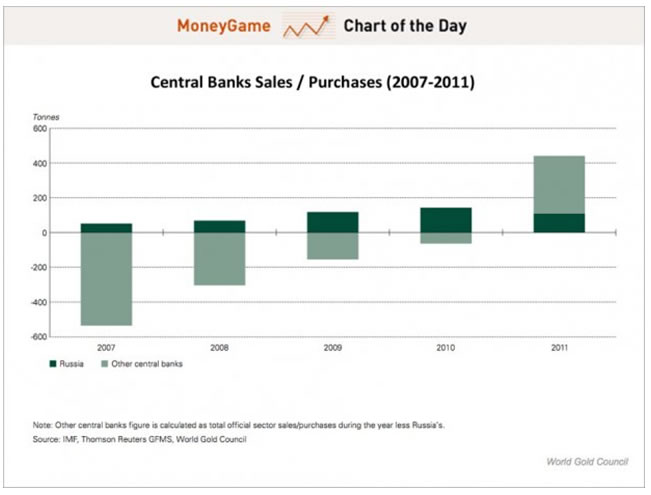
Gold is now seen not only as a source of collateral for loans but also act as a venue for Centrals Banks to diversify their foreign reserves. Instead of depending on building up their foreign reserves with US$ or Euros and risked being devalued, they now accumulate physical gold to counter that.
Debt Resetting
Another reason for the accumulation of gold by Central Banks is that there are seeing something that we don’t. Legendary investor Soros is reportedly selling all his banking shares and converting them into gold investments. Even John Paulson, who made more than US20 billion by betting against the housing boom is diversifying more than 60% of his funds into gold. Big Money had been manipulating the gold price through the futures market like LME and CME to keep them low so that they can accumulate physical gold on the cheap.
There will come a time when they have accumulated enough gold and then without any notice they will push the price of gold ‘through the roof’. At the meantime the dollar will further devalued due to the ‘capital flight’ to gold. By that time Central Banks and Big Money will start liquidating their physical gold holdings to sterilize their debts or in other words there will be a ‘resetting of debts’. After that they will be solvent and continue the vicious cycle of debt accumulation-plundering-bailouts again. So isn’t it time for folks like us to liquidate our ‘paper investments’ to start accumulate physical gold?by Sam Chee Kong
cheekongsam@yahoo.com
© 2012 Copyright Sam Chee Kong - All Rights Reserved
Disclaimer: The above is a matter of opinion provided for general information purposes only and is not intended as investment advice. Information and analysis above are derived from sources and utilising methods believed to be reliable, but we cannot accept responsibility
© 2005-2022 http://www.MarketOracle.co.uk - The Market Oracle is a FREE Daily Financial Markets Analysis & Forecasting online publication.



